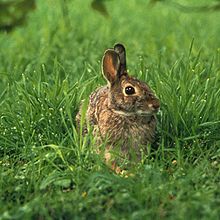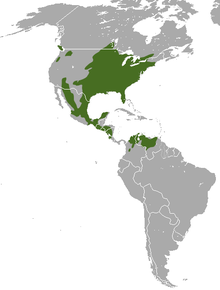Florida Cottontail
| Florida Cottontail | ||||||||||||
|---|---|---|---|---|---|---|---|---|---|---|---|---|

Florida Cottontail ( Sylvilagus floridanus ) |
||||||||||||
| Systematics | ||||||||||||
|
||||||||||||
| Scientific name | ||||||||||||
| Sylvilagus floridanus | ||||||||||||
| JA Allen , 1890 |
The eastern cottontail ( Sylvilagus floridanus ), and Eastern cottontail rabbit called, is the North American most widely used type of cottontail rabbit . The distribution area extends from Canada from southern Québec and Manitoba over the entire eastern and central United States and over Mexico and Central America to Colombia and Venezuela .
features
Like all cottontail rabbit also eastern cottontail its name because of the soft, white fur on the underside of their tail. When they run, show them off. The head-torso length is between 40 and 49 cm, in contrast to most mammals , the females are larger than the males. Their weight is 800 to 1,500 g. Their soft fur is mottled gray-black, while their dense undercoat shows brown through. The back and sides are gray, the belly is white and the neck fur is reddish-brown. Twice a year they change their fur, the summer dress (change between mid-April and mid-July) is short and deep brown, the winter dress (change between mid-September and end of October) is longer and gray. For their height, they have noticeably large, sideways-lying eyes, with which they have a very good panoramic view. The dark gray-yellow-brown, black bordered, elongated ears are between 50 and 70 mm long, and the tail has a length of up to about 50 mm. Their approximately 90 to 100 mm long, well-developed hind legs enable the Florida cottontails to jump up to three meters and speeds of 40 km / h. There are five toes on the front feet and four on the back feet. There are four pairs of teats on the stomach. Florida cottontails make different sounds:
- Warning shouts: to scare an enemy or warn others of danger,
- Screeching: during copulation and
- Grunts: when an enemy approaches the nest or the offspring.
Florida cottontails live to be around three years in the wild, but many do not live to be old.
Distinction
Since the cottontail rabbits are very similar, it is often difficult to distinguish them with certainty. The Audubon cottontail rabbit ( Sylvilagus audubonii ) is slightly smaller and longer-eared than the Florida cottontail rabbit, while the mountain cottontail rabbit ( Sylvilagus nuttallii ) is lighter and significantly smaller.
behavior
Florida cottontails are mostly nocturnal, but individual specimens can also be observed in the early morning and evening. During the day they lie in their flat sasse on the ground between tall grass or in the forest. In contrast to many European rabbit species , they do not build burrows, but when it is dangerous or cold they crawl into the structures of other animals, such as the woodchuck ( Marmota monax ). In deep snow, Florida cottontails dig large systems of ducts, comparable to those of field mice and mountain hares . Florida cottontails are solitary animals that act aggressively on fellow animals. Their territories vary in size, depending on the nature of the surface and what food they have to offer. Thus the area is about two to four hectares, increasing in the breeding season. Males have a larger territory than females. Florida Cottontails are very good at seeing, smelling, and hearing. They are nocturnal and do not hibernate. To observe the surroundings, they stand on their back legs and put their front paws on their chest. Escape methods include suddenly standing motionless, hitting a hook, and crouching with big ears. Florida cottontails don't like to go into the water unless they are urged to do so by an enemy.
Occurrence
Florida cottontails occur in Canada from southern Québec and Manitoba over the area from the Rocky Mountains to the Atlantic Ocean to Colombia and Venezuela . Of all the cottontail rabbit species, they inhabit the greatest variety of habitats; they are found in deserts and steppes , in forests, swamps and in the vicinity of human settlements. In the past they were also found in coniferous and rain forests , but today they prefer clearings, forest edges and moors . Their habitat includes meadows, orchards, farmland, areas with hedges, sub-grown bushes and young deciduous trees. The females in particular, but also the males, remain true to their location in an area that mostly overlaps with that of other conspecifics. They are very common with other species of the rabbit family (Leporidae).
nutrition
Florida cottontails eat their food two to three hours at dawn and one hour after sunset. Like all rabbits and hares, they mainly feed on grass and herbs, they are not picky about their food. They also eat fruits. In winter, when there is a lack of food, they also eat the bark of trees, twigs and seeds.
Their digestive system is very well adapted to their food, which causes them to drop two forms of feces : hard fecal pills and soft feces. They take up the latter again, as it contains more vitamin B1 through microbial decomposition than they can produce themselves.
Reproduction
Florida cottontails breed from February to September. Before copulating, they perform an interesting ritual together shortly after sunset. The male chases after the female until it turns around and looks at him. Then she punched him with her front paws. Then they stay in front of each other until one of the couple makes a jump of up to 60 cm for joy. This is repeated by both until the female is ready to mate. After a gestation period of 25 to 30 days, up to seven cubs (three to four cubs on average) are thrown into a hollow in the ground under bushes or in tall grass, covered with soft grass and peritoneum. You are completely naked at this point with your eyes still closed. They have a litter size of around 10 cm and weigh only around 30 g. But they develop very quickly (2.5 g per day), after about four to five days they open their eyes, and after a week they are already making their first attempts to walk and have a complete coat. The female hardly cares about the offspring, they are only suckled once or twice a day (morning and evening) until they are around 16 days old. In about two to three weeks they will be independent of the adult animals. Florida cottontails are sexually mature and able to reproduce at around two to three months old. From seven weeks on, the littermates go their own way.
A female can give birth to four to five litters a year. She usually throws after the last litter has just left the nest. However, the boy mortality rate is around 90%.
Hazard and protection
The Florida cottontail is classified by the International Union for Conservation of Nature and Natural Resources (IUCN) as least concern due to the size of the population and the large area of distribution. It is a generalist both in its diet and in terms of populated habitats, and no decline in populations is known.
The natural predators of the Florida cottontails are snakes , birds of prey , big cats , wild dogs , weasels, and raccoons . Florida cottontails have the largest populations of their genus and are therefore not considered threatened. There are many sport shooters in the United States who specialize in Florida cottontails. They are easy prey as they often live near settlements and in the green spaces of large cities.
Economy
Florida cottontails destroy garden and farmland in summer with their foraging, in winter they pose a problem for foresters, fruit and landscape gardeners. In addition, humans can contract rabbit plague from the carcasses of infected individuals . On the other hand, Florida cottontails are very common and edible, and hunting has become a popular game of hunting. The meat and fur are processed for humans. Because of their high number of offspring, they are also used for animal experiments.
supporting documents
- ↑ Sylvilagus floridanus in the endangered Red List species the IUCN 2011. Posted by: Mexican Association for Conservation and Study of Lagomorphs (AMCELA) Romero Malpica, FJ & H. Rangel Cordero, 2008. Accessed June 10, 2012th
literature
- Joseph A. Chapman, John EC Flux (Eds.): Rabbits, Hares and Pikas. Status Survey and Conservation Action Plan. (PDF; 11.3 MB) International Union for Conservation of Nature and Natural Resources (IUCN), Gland 1990; Pp. 102-103. ISBN 2-8317-0019-1
- Joseph A. Chapman, J. Gregory Hockman, Magaly M. Ojeda C .: Sylvilagus floridanus . In: Mammalian Species . tape 136 , 1980, pp. 1–8 ( full text [PDF; 960 kB ]).
Web links
- Sylvilagus floridanus in the endangered Red List species the IUCN 2011. Posted by: Mexican Association for Conservation and Study of Lagomorphs (AMCELA) Romero Malpica, FJ & H. Rangel Cordero, 2008. Accessed June 10, 2012th
- www.markuskappeler.ch - Florida Cottontail



